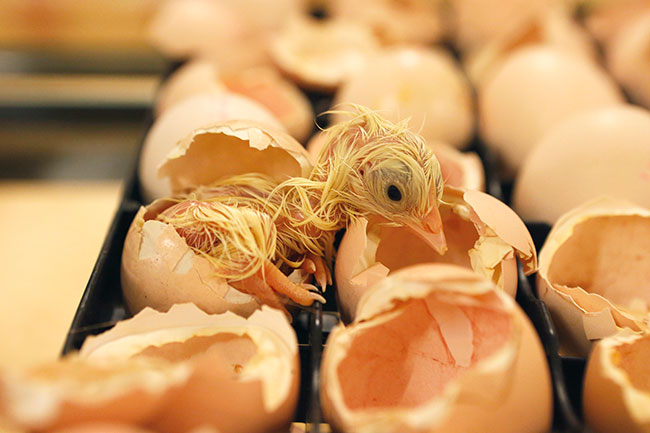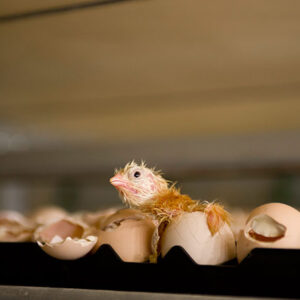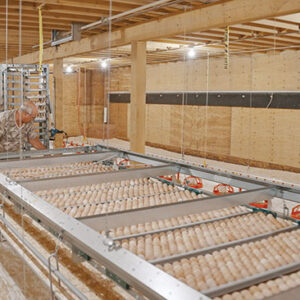
On-farm hatching takes flight
By Treena Hein
Features Emerging Trends Poultry Equipment on-farm hatchingIn a rising trend, on-farm hatching gains traction in North America as equipment leaders enter market, backed by promising research results.
 A growing trend in the European poultry industry over the last 20 years, on-farm hatching is now making inroads in North America.
PHOTO CREDIT: vencomatic
A growing trend in the European poultry industry over the last 20 years, on-farm hatching is now making inroads in North America.
PHOTO CREDIT: vencomatic On-farm hatching is a concept that’s grown in popularity across the European poultry industry over the last 20 years, and it’s now making inroads in the U.S. and Canada.
Two main equipment companies, Vencomatic Group and NestBorn, have recently entered the North American market, and another European manufacturer, One2born, may follow. Some farmers in Europe, North America and beyond have also devised their own systems.
A Canadian customer of the Vencomatic system is Groupe Westco in New Brunswick. “I only know of two broiler farmers confirmed to be using this method of hatching,” says Groupe Westco agrologist Marco Volpe, “us in New Brunswick and another one in Quebec. I know other farmers in Canada are running some tests, but I can’t say how many and where.”
And while that’s a small number so far, Volpe says, “I expect more will adopt this type of hatching since Canadian Food Inspection Agency (CFIA) changed its policy. Since new regulations are in place, I expect more farms will adopt this practice in 2024. Before, CFIA was regulating every barn as a hatchery, so every barn needed a hatchery licence.”
But, with the changes from about 18 months ago in place, barns are “now regulated by Chicken Farmers of Canada with their Animal Care Program and On Farm Food Safety Program,” Volpe says.
Operational details
In New Brunswick, Groupe Westco has installed systems in several three-storey broiler barns (40 feet wide with cross ventilation, propane heat for brooding, shaving for bedding), with no changes needing to be made to the buildings. Volpe notes that in Quebec, the system is installed in two-storey barns.
ROI is of course unique to each operation and going to depend on factors such as whether the farm is integrated (and hatching success rate) or buys chicks (distance from existing hatchery and chick cost, etc.). In Volpe’s view, ROI mainly depends on how much automation is used.
“There are so many ways to look at ROI with all the different types of in-barn hatching,” he adds. “It could be as simple as collecting and putting the eggs directly on the floor manually to a more complex suspension system that won’t touch the floor and can spread the eggs evenly in the barn without having to walk to barn when placing and removing them.”
New research results
The benefits of on-farm hatching was well established. Giving newly hatched chicks immediate access to feed and water, and sparing them the stress of transport from hatchery, can provide health and bird welfare advantages.
However, here are some newish results involving Groupe Westco.
Scientists from Wageningen and Utrecht Universities in Europe conducted a two-year study with lab-scale trials but also commercial-scale trials during three consecutive cycles at Groupe Westco, where 150 tests were run comparing flocks of 7,500 to 9,700 Ross 308 or Cobb 500 broilers hatched on-farm with X-Treck or in the hatchery.
Data was collected on hatchability, mortality and body weight, as well as feed conversion ratio and number of foot lesions (an important welfare issue in broiler production).
Hatchability was found to be on average 2.5 per cent higher with X-Treck compared to hatchery chicks, with 10 per cent of the trials showing a boost of more than four per cent. Ross flocks had slightly higher hatchability (2.54 per cent) than Cobb (2.35 per cent), and young parent flocks (ages 27 to 29 weeks) had the largest increase in egg hatchability (3.69 per cent) with X-Treck.
“Mortality was studied during the entire production period, showing a decrease in first week mortality of 0.24 per cent for X-Treck chicks compared to hatchery-hatched chicks,” reports Vencomatic. “The difference in mortality is largest in the final stretch of the cycle, after 30 days of age. Total mortality was, on average, 0.32 per cent lower for X-Treck flocks, with decreases up to 9.4 per cent in some flocks.”
Cobb flocks with on-farm hatching showed an average decrease of 0.42 per cent in total mortality compared to 0.26 per cent for Ross flocks. And again, age of parent flocks had a small positive effect on mortality.
In addition, higher body weights were measured at all ages in X-Treck broilers compared to hatchery chicks (see Table 2 online) and body weights were highest for chicks of young parent flocks. Feed conversion ratio was slightly higher in on-farm hatched chicks.
Regarding welfare, it’s well known that immediate access to feed and water for on-farm hatched chicks provides better development of the digestive system. “This can result in less wet manure, which is the main cause of foot pad lesions,” notes Vencomatic Group. “Only 22 per cent of the chicks hatched on-farm had foot pad lesions at the age of 21 days compared to 51 per cent of hatchery chicks (see Figure 2 online).”
Severe foot pad lesions were seen in only two per cent of on-farm hatched broilers compared to eight per cent of those hatched in the hatchery. At day 35, similar differences were found.
Other recent studies have produced some similar results. Dr. Jennifer Timmons, associate professor at University of Maryland (Eastern Shore) recently noted a Ross chick study conducted in The Netherlands that found lower hatchability in the hatchery (4.25 per cent) compared to 2.3 per cent on-farm. Total mortality at 40 days was lower (3.4 per cent) in the flock that was hatched on-farm compared to hatchery chicks (4.01 per cent) and the litter was drier with on-farm hatched chicks.
However, there were some differences between the studies in terms of welfare. The differences could be due to hatcheries varying in performance, bird genetics, on-farm management or other factors.
“The on-farm hatched chicks had a worse naval and hock score at day 0 compared to the score of the chicks that were hatched in the hatchery,” Timmons stated in a recent extension article. In addition, “the authors reported that the on-farm hatched chickens were heavier at 21 days of age compared to the weight of the chickens that were hatched at the hatchery. However, the weight of the birds at 40 days of age was similar regardless of the hatching process.”
Make an informed decision
As Volpe is on the front lines of using on-farm hatching in Canada, let’s give him the last word.
While Groupe Westco chose Vencomatic’s X-Treck system, he stresses that “there are a lot of different ways to hatch on farm. I know a lot of other ways for farmers to do it in Europe. Farmers need to look at all options and see which one would work best for them.”
A quick look at some on-farm hatching systems
Vencomatic Group
X-Treck uses trays placed on a rail system that is suspended from a range of heights to enable management of airflow and temperature.
One2born
Trays with airflow features are placed directly on the barn floor. They are easy to stack during transport, with sufficient insulation and design to prevent cracking.
NestBorn
Trays are also placed directly on the barn floor.
Print this page

